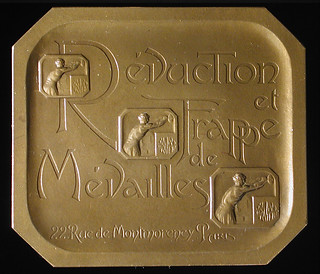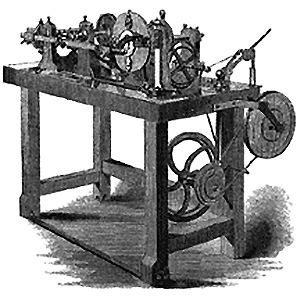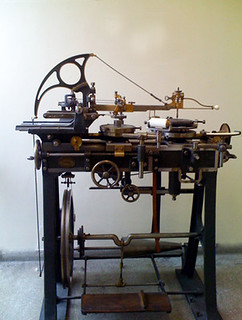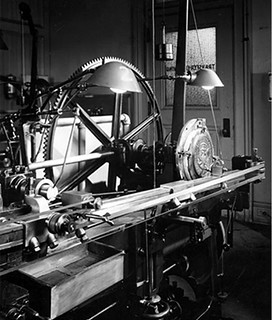
PREV ARTICLE
NEXT ARTICLE
FULL ISSUE
PREV FULL ISSUE
REDUCTION MACHINES AT THE U.S. MINTRobert C Whitehead writes:"The article in the last E-Sylum referenced the Janvier Reducing Machine which I believe is still in use today in some quarters because of its accuracy. In my research I discovered that prior to the Janvier there was the Hill Pantograph, and then before that the Contamin Pantograph." Here is Robert's writeup on the machines from his detailed web site on the 1881-O Morgan Dollar. Thanks! -Editor Before the Days of the Pantograph
All dates, stars, and other embellishments were added not to the master die but to the working dies. The addition of these devices so late in the process all but ensured that there would be both errors and die varieties. This methodology was in place until 1836 when the first Contamin pantograph was purchased for the Philadelphia Mint. Contamin Pantograph
This was the first die-engraving pantograph that used a rotating cutter. This in effect transformed the pantographic into a mechanically controlled milling machine, instead of a copying lathe. The inventor, Contamin (the remainder of his name has been lost to time) was French. Contamin redesigned or adapted an earlier French mechanical pantograph, created by Jean Baptiste Dupeyrat. Contamin's engraving pantograph was in widespread use for over 60 years and its use overlapped the invention of the next generation for years. Hill Pantograph
The U. S. Mint purchased its first Hill pantograph from William Wyon in September of 1867. It was received and placed in use in 1868. However, mint engravers still use the Hill pantograph like they had used their Contamin. Perhaps it was comfort with the old process, but they only used it to make hubs of primary design devices from oversize models. Lettering and numbers were added by hand. In the 1867 Annual Report Mint Director Henry R. Linderman wrote "this important and interesting machine … reduces copies of bas-reliefs by which the freedom of execution of the larger model is susceptible in the hands of the artist, can be preserved in the most minute proportions … to the face of the coin for which it is designed." The photograph is from the Royal Mint in Brittan and is the only known picture of this important piece of equipment we have been able to locate. On May 11, 2015 we did receive positive confirmation from a Mint representative that this is the Hill lathe. Please note that the reducer was treadle powered, making control difficult for the operator and probably requiring some significant skill to master. It has also been reported that the U. S. Mint had their equipment modified, so it likely looked somewhat different. We contacted the U. S. Mint in Philadelphia in May 2015 to see if they have a photograph of their model, but so far there has been no response. Janvier Pantograph
Saint-Gaudens model for the high relief $20 gold coin was to be the first American coin reduced on the Janvier machine. Medallic Art founder Henri Weil, who had instructed mint engravers on how the Janvier pantograph was operated. He was later asked by Saint-Gaudens assistant, Henry Hering, for assistance in lowering the relief. Chief engraver Charles E. Barber declared that Saint-Gaudens' model was still unworkable, the relief was still too high, and it was ultimately lowered for the two varieties of this coin in 1907. In this video from The Royal Mint there is a Janvier reduction machine briefly shown in use, a rare glimpse into the past. Apparently it was in use for over 100 years. In the illustration on the left the important features of the machine are evident. The arm with the tracing mechanism on the right and the cutting bit on the left are in their proper place for work. A little more difficult to see, but there, are the belts running across the front. These belts allowed the cutting head more freedom as the design was cut. Since the tracing head was traveling a longer distance as you moved out from the center of the design. The belts allowed for more accurate synchronization between the two heads. This was the improvement over the Hill machine that precipitated the change. An interesting side note on the Janvier is that it was perhaps too good. Apparently the machine was so accurate and so well made that once acquired it never needed replacing. According to the British Royal Museum the company went out of business for lack of obsolescence. This can be confirmed because we see advertisements for them today some 100 years after their introduction.   Michael Wehner writes: "I enjoyed learning more about the Duval Janvier reduction machine. Here is a picture of my example of the medal by Charpentier of the Duval Janvier company. My son, Elliot, also a numismatist, and I were visiting the Metropolitan Museum of Art in New York, when we saw this particular medal in a case. I mentioned that I was thinking about getting one and he asked "How much are they worth?" I replied "Oh about a hundred bucks or so". He answered "Dad, what other piece of art in this museum can you buy for a hundred dollars?" That started a whole collection... " To read the earlier E-Sylum article, see:
 Wayne Homren, Editor The Numismatic Bibliomania Society is a non-profit organization promoting numismatic literature. See our web site at coinbooks.org. To submit items for publication in The E-Sylum, write to the Editor at this address: whomren@gmail.com To subscribe go to: https://my.binhost.com/lists/listinfo/esylum All Rights Reserved. NBS Home Page Contact the NBS webmaster 
|


